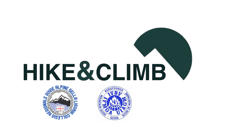
Hike&Climb
Follow us on
E-mail
Main office address
Via Colombo 7/27 - GENOA
tel. +39 347 0345016
16121
Italy
The Outdoor Ligurian Choice
© Hike&Climb
Sport climbing, what are the risks? The Alpine Guides' checklist
16, Jun, 2022 / by Italian Alpine Guides Press Office
Every year, climbing attracts more and more enthusiasts, who discover the pleasure of vertical movement by taking their first steps in indoor gyms. The transition to rock is easy and almost spontaneous, but knowing how to climb, even well, in an artificial structure does not mean being prepared to visit a natural crag, because the mountain environment always presents dangers and risks of which it is important to be aware. Which ones? Let's find out together with the Alpine Guides, climbing professionals who teach, in addition to rock climbing techniques, how to manage risk in mountain sports and activities.
We have compiled a list of questions that everyone should ask themselves when deciding which crag to go to and once on site: not to be considered exhaustive and sufficient, but a useful initial tool for the prevention of accidents or near-accidents.
PREPARATION AT HOME
Before heading out to discover a new crag, it is a good idea to check your technical level and equipment and do your research so you arrive at the walls prepared. Look for information on the weather and the conditions of the crag, asking, for example, the Alpine Guides or experienced locals.
Is it possible for rocks to fall from above the crag due to wind or wild animals?
- Windless day: OK!
Windy day: it may be appropriate to change crag or sector
- What is the bolting like?
Recent and closely spaced fix or resin bolts: OK!
Long distances between bolts: better bring gear to supplement
Obsolete bolts: it is advisable to check the condition of intermediate protections and anchors
- What is the exposure of the crag, in the sun or shade?
In the sun in winter, in the shade in summer: OK!
In the sun in summer: beware of sunstroke, dehydration, and excessive fatigue due to high temperatures. It is a good idea to plan activity times, take advantage of shady hours, and always bring suitable clothing and plenty of drinks, especially with children.
- What are the conditions of the crag?
Dry: OK!
Wet: Pay particular attention to wet and slippery holds; if you are just starting to lead climb, only top-rope climbing is appropriate.
Rock not worn by traffic: OK!
Rock greasy, especially for feet: if you are just starting to lead climb, only top-rope climbing is recommended
- How is your equipment?
Certified and not expired helmet and harness: OK!
Suitable approach shoes: OK!
Climbing shoes in good condition: OK!
Belay device and lanyard with carabiner not worn: OK!
First aid kit: OK!
Ropes of adequate length for the pitches: OK!
Belay devices suitable for the rope diameter: OK!
Sufficient number of quickdraws: OK!
Locking carabiners for anchor back-up: OK!
Approach shoes with slippery or city soles and therefore not suitable: STOP! Replace your equipment
Worn and/or expired harness: STOP! Replace your equipment
Old or homemade quickdraws: STOP! Replace your equipment
BEHAVIOR AT THE CRAG
The crag environment, especially if well-known and frequently visited, can lead to underestimating risk and to overconfidence due to familiarity with the place (short approaches, equipped areas) and the people there (friends, acquaintances). During activity, pay attention to your own and your partner's behavior:
- Are there risks to concentration?
Is there mutual checking every time before starting to climb? OK!
Are there friends and nearby teams distracting us? STOP! Regain concentration
Does someone interrupt the operations we are performing (e.g. closing the harness, tying the knot, belaying actively with continuous attention, etc.)? STOP! Regain concentration
Are there signs of fatigue? STOP! It's time to take a break to drink, eat, rest, or take photos.
- How does the belayer behave?
Is he/she well positioned, constantly attentive to the partner's progress, demonstrates knowledge of the belay device, the rope is of adequate length for the pitch to be climbed, and has tied a knot at the end of the rope: OK!
Is he/she at an excessive or insufficient distance from the wall, leaves slack in the rope, belays statically, uses the belay device incorrectly: STOP! Correct all wrong behaviors by watching or asking someone more experienced than us
- Can I lead climb?
Belayer and climber of equal weight: OK!
Belayer and climber of unequal weight (generally over 20 kg difference), child or teenager belaying an adult or peer: STOP! Increase angles and rope friction by using non-linear protections



Hike&Climb
Follow us on
E-mail
Main office address
Via Colombo 7/27 - GENOA
tel. +39 347 0345016
16121
Italy
The Outdoor Ligurian Choice
© Hike&Climb
